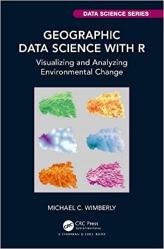 Название: Geographic Data Science with R: Visualizing and Analyzing Environmental Change
Название: Geographic Data Science with R: Visualizing and Analyzing Environmental ChangeАвтор: Michael C. Wimberly
Издательство: CRC Press
Серия: Data Science Series
Год: 2023
Страниц: 310
Язык: английский
Формат: pdf (true)
Размер: 44.1 MB
The burgeoning field of Data Science has provided a wealth of techniques for analysing large and complex geospatial datasets, including descriptive, explanatory, and predictive analytics. However, applying these methods is just one part of the overall process of geographic Data Science. Other critical steps include screening for suspect data values, handling missing data, harmonizing data from multiple sources, summarizing the data, and visualizing data and analysis results. Although there are many books available on statistical and Machine Learning methods, few encompass the broader topic of scientific workflows for geospatial data processing and analysis.
The purpose of Geographic Data Science with R is to fill this gap by providing a series of tutorials aimed at teaching good practices for using geospatial data to address problems in environmental geography. It is based on the R language and environment, which currently provides the best option for working with diverse spatial and non-spatial data in a single platform. Fundamental techniques for processing and visualizing tabular, vector, and raster data are introduced through a series of practical examples followed by case studies that combine multiple types of data to address more complex problems.
The Chapter 1 provides a brief introduction to the R programming language. The goal is to give just enough background to allow readers to move on quickly to the subsequent chapters, which focus on more advanced applications of R for geospatial data processing, analysis, and visualization. To understand and apply these techniques, it is essential to know the basic R objects that store various types of data. It is also necessary to understand how functions are used to manipulate these objects. Functions typically take one or more objects as inputs and modify them to produce a new object as the output. These concepts will be demonstrated by using R to perform a series of simple data processing tasks such as making basic calculations, applying these calculations over larger datasets, querying subsets of data that meet one or more conditions, creating graphics, and carrying out basic statistical tests.
The book will have a broad audience. Both students and professionals can use it as a workbook to learn high-level techniques for geospatial data processing and analysis with R. It is also suitable as a textbook. Although not intended to provide a comprehensive introduction to R, it is designed to be accessible to readers who have at least some knowledge of coding but little to no experience with R.
Key Features:
Focus on developing practical workflows for processing and integrating multiple sources of geospatial data in R
Example-based approach that teaches R programming and data science concepts through real-world applications related to climate, land cover and land use, and natural hazards.
Consistent use of tidyverse packages for tabular data manipulation and visualization.
Strong focus on analysing continuous and categorical raster datasets using the new terra package
Organized so that each chapter builds on the topics and techniques covered in the preceding chapters
Can be used for self-study or as the textbook for a geospatial science course.
Скачать Geographic Data Science with R: Visualizing and Analyzing Environmental Change